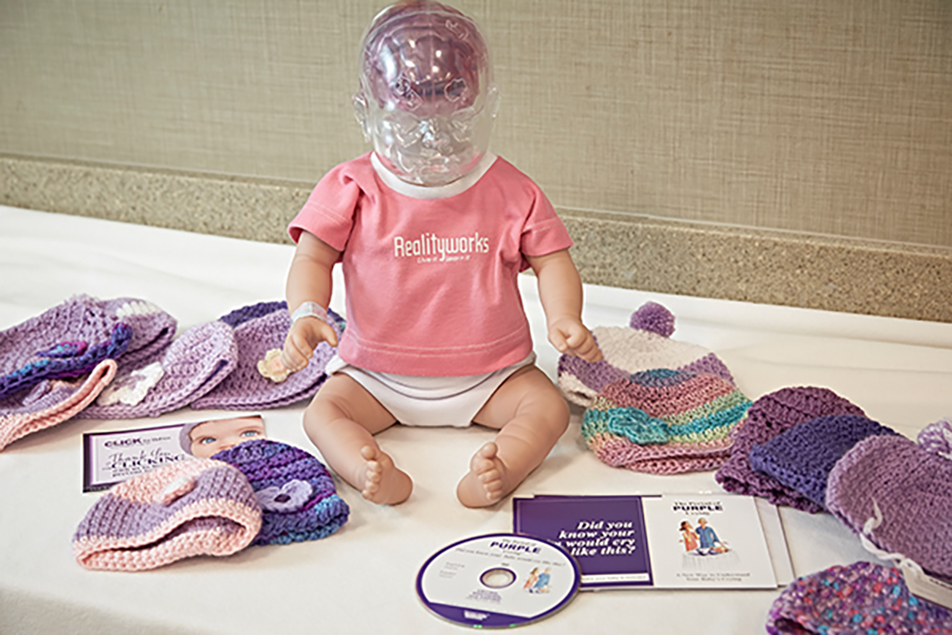
According to the National Children’s Alliance, in 2015, an estimated 1,670 children died from abuse and neglect in the United States. April is Child Abuse Prevention Month, and an important opportunity to start the discussion around some of the challenges of being new parents.
The Period of PURPLE Crying was a term designated by the National Center on Shaken Baby Syndrome (NCSBS), in partnership with hospitals, public health and child abuse prevention groups, to identify the stage in an infant’s development, typically 2 weeks through 3-4 months, where they might be more prone to express themselves through actions that can trigger tired, unintentionally impatient caregivers to act out in frustration. This time period and the habits that accompany it have traditionally been referred to as “colic” and treated through medication, but professionals in the medical and mental health fields are encouraging moms and dads to accept this as a normal part of development and plan for healthy coping mechanisms.
The word “PURPLE” is actually an acronym for:
P: Peak of crying
U: Unexpected
R: Resists soothing
P: Pain-like face
L: Long lasting
E: Evening
We asked Erin Norton, RN, BSN, IBCLC, clinical research nurse and program coordinator, Parkview Women’s and Children’s Hospital, to share more on how Parkview is supporting the Period of PURPLE Crying education initiative for local parents.
Q. How does the Period of PURPLE Crying correlate with the elevated Infant Mortality Rate in our area?
Sadly, some babies who are shaken can suffer abusive head trauma that can lead to death. Understanding why babies cry and knowing the appropriate response can reduce the incidents of trauma. Parents will know the right thing to do rather than shake the baby out of frustration.

Q. What is Parkview specifically doing to support parents during the Period of PURPLE Crying?
Understanding that some periods of crying are a normal part of development can give parents hope. Every parent that delivers at Parkview receives education — pamphlets and a DVD – and they can look at a simulation doll. The simulation doll cries, and when you shake it different areas of the bran light up to let you know where you’re causing damage. When the doll stops crying, the parents know they’ve caused more serious damage. People are often surprised how little shaking it takes to cause trauma.
Q. What are some simple things parents can do to cope during this Period of PURPLE Crying?
First, just be aware and remember that crying is developmentally normal. This can help ease anxieties and curb frustration.
The best thing to do if the baby is crying and you’re feeling frustrated is to put the baby in a safe place (such as a crib) and walk away for a few minutes until you can calmly return to the situation. It’s important to remember that it’s okay to step away and collect yourself.
Q. Why is it so important to give this time in a baby’s life a name and establish these support resources?
The knowledge that this stage is normal can make a significant impact. Sometimes parents may not be confident that they’re doing the right thing for their child. They may wonder why they can’t calm their child and feel like they’re failing when it’s actually a normal stage of the baby’s development.
Q. What resources are available to parents through Parkview?
The delivery pamphlets, etc. mentioned previously. We are also going out into the community and educating the general public; Parents aren’t the only people who need to know this information. Anyone who could be left alone to care for the child needs the education (babysitters, aunts, uncles, grandparents, etc.). This has been a primary focus for Parkview.
This education is partly possible through funding received through Fort Wayne Children’s Foundation. It’s the second year for the grant, which makes educational materials for in-patient and part of the community awareness campaign possible.
More information available at:
www.dontshake.org
http://www.purplecrying.info/
www.clickforbabies.org



